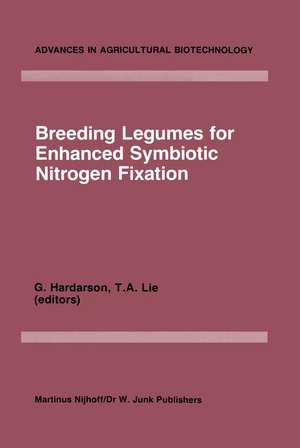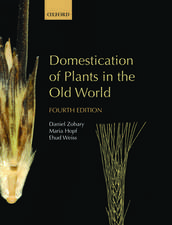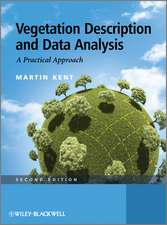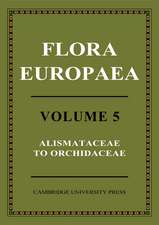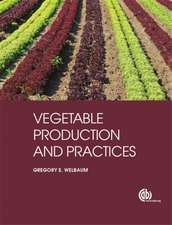Breeding Legumes for Enhanced Symbiotic Nitrogen Fixation: Proceedings of an FAO/IAEA Consultants' Meeting, held in Vienna, 26–30 September 1983: Advances in Agricultural Biotechnology, cartea 12
Editat de Gudni G. Hardarson, T.A. Lieen Limba Engleză Paperback – 13 oct 2011
Din seria Advances in Agricultural Biotechnology
-
 Preț: 386.00 lei
Preț: 386.00 lei - 15%
 Preț: 662.62 lei
Preț: 662.62 lei -
 Preț: 383.33 lei
Preț: 383.33 lei - 18%
 Preț: 1381.74 lei
Preț: 1381.74 lei - 18%
 Preț: 1217.41 lei
Preț: 1217.41 lei - 15%
 Preț: 641.38 lei
Preț: 641.38 lei - 18%
 Preț: 949.23 lei
Preț: 949.23 lei - 18%
 Preț: 1231.47 lei
Preț: 1231.47 lei - 18%
 Preț: 1221.20 lei
Preț: 1221.20 lei - 18%
 Preț: 950.21 lei
Preț: 950.21 lei -
 Preț: 402.38 lei
Preț: 402.38 lei -
 Preț: 421.23 lei
Preț: 421.23 lei - 18%
 Preț: 950.33 lei
Preț: 950.33 lei - 18%
 Preț: 1216.48 lei
Preț: 1216.48 lei -
 Preț: 384.31 lei
Preț: 384.31 lei -
 Preț: 384.31 lei
Preț: 384.31 lei - 18%
 Preț: 1217.41 lei
Preț: 1217.41 lei - 18%
 Preț: 1226.42 lei
Preț: 1226.42 lei -
 Preț: 394.29 lei
Preț: 394.29 lei -
 Preț: 416.26 lei
Preț: 416.26 lei - 18%
 Preț: 953.20 lei
Preț: 953.20 lei -
 Preț: 386.99 lei
Preț: 386.99 lei -
 Preț: 394.87 lei
Preț: 394.87 lei -
 Preț: 392.60 lei
Preț: 392.60 lei
Preț: 381.98 lei
Nou
Puncte Express: 573
Preț estimativ în valută:
73.10€ • 76.22$ • 60.75£
73.10€ • 76.22$ • 60.75£
Carte tipărită la comandă
Livrare economică 20 martie-03 aprilie
Preluare comenzi: 021 569.72.76
Specificații
ISBN-13: 9789401087469
ISBN-10: 9401087466
Pagini: 188
Ilustrații: 184 p. 13 illus.
Dimensiuni: 160 x 240 x 10 mm
Greutate: 0.27 kg
Ediția:Softcover reprint of the original 1st ed. 1984
Editura: SPRINGER NETHERLANDS
Colecția Springer
Seria Advances in Agricultural Biotechnology
Locul publicării:Dordrecht, Netherlands
ISBN-10: 9401087466
Pagini: 188
Ilustrații: 184 p. 13 illus.
Dimensiuni: 160 x 240 x 10 mm
Greutate: 0.27 kg
Ediția:Softcover reprint of the original 1st ed. 1984
Editura: SPRINGER NETHERLANDS
Colecția Springer
Seria Advances in Agricultural Biotechnology
Locul publicării:Dordrecht, Netherlands
Public țintă
ResearchCuprins
Efficiencies and inefficiencies in the legume/Rhizobium symbiosis — A review.- Improving nitrogen fixation in legumes by plant breeding; the relevance of host selection experiments in red clover (Trifolium pratense L.) and subterranean clover (T. subterraneum L.).- A multiple-trait breeding program for improving the symbiosis for N2 fixation between Medicago sativa L. and Rhizobium meliloti.- Selection for improved nitrogen fixation in Glycine max (L.) Merr. and Phaseolus vulgaris L..- Developing a breeding strategy to exploit quantitative variation in symbiotic nitrogen fixation.- Mutation breeding of grain legumes.- Gene centres, a source for genetic variants in symbiotic nitrogen fixation: The symbiotic response of the cultivated pea to Rhizobium leguminosarum strains from Europe and the Middle East.- Field evaluation of symbiotic nitrogen fixation by rhizobial strains using 15N methodology.- Rhizobium inoculation trials designed to support a tropical forage legume selection programme.- Breeding soybeans for the tropics capable of nodulating effectively with indigenous Rhizobium spp..- Effect of plant genotype and nitrogen fertilizer on symbiotic nitrogen fixation by soybean cultivars.- Quantitative assessment of symbiotic nitrogen fixation in diverse mutant lines of field bean (Vicia faba minor).- Host genes in Pisum sativum L. conferring resistance to European Rhizobium leguminosarum strains.- Modification of symbiotic interaction of pea (Pisum sativum L.) and Rhizobium leguminosarum by induced mutations.
